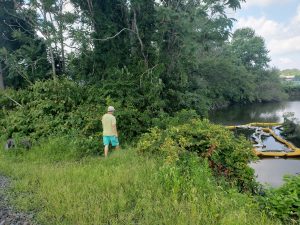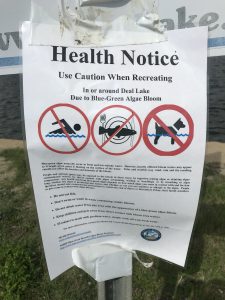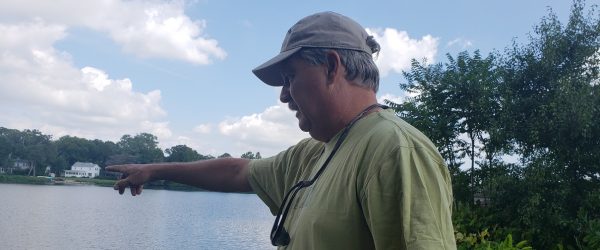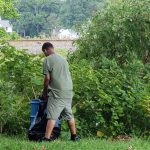Brockel: Deal Lake Is Not Closed
DLC Chair Pledges To Work With State Officials To Ensure Overreaction To An Annual Natural Occurrence Does Not Occur Again Next Year
Recreational activities on Deal Lake has remained at a standstill ever since testing by the Monmouth County Health Dept showed the presence of cyanobacteria, a naturally-occurring photosynthetic bacteria more commonly known as blue green algae.
“The traffic on Deal Lake is non existent,” said Brian Watkins, owner of Deal Lake Dock Co, located at the Deal Lake Boat Ramp site across from 7-Eleven. “There were hundreds of people kayaking and boating on the lake but since the new broke [July 31] not a single person has dropped a canoe or a kayak.”
Watkins is an avid fisherman who launched his canoe and kayak rental business last year. The company also sells bait and tackle from its mobile truck and employs a 15-year-old Asbury Park High School student with ambitions of becoming a marine biologist.
“It’s not a huge hit but it’s definitely taken a hit,” the 12-year long city resident said. “The larger issue here is that we really don’t have any guidelines from the state.”
Watkins, like Deal Lake Commission Chair Don Brockel, is concerned that the reports are damaging.
Both made reference to the fact that precautionary measures, such as rinsing off after being on the lake, would mitigate any harm of participating in recreational activities such as boating or kayaking.
“It’s pretty sad that no one is on the lake because it is not toxic,” Watkins said. “The algae bloom is barely noticeable.”
“It’s like going into the woods,” Brockel said. “You know there are tics there but you use precautions [like a spray, the right clothing and checks] but you don’t stop enjoying something you like.”
Deal Lake is is the largest waterbody in Monmouth County, occupying 158 acres bordered by seven municipalities – Allenhurst, Asbury Park, Deal, Interlaken, Loch Arbour, Neptune Township and Ocean Township. The Commission was formed in 1974 to help save the lake and address environmental pollutants that plagued the waterbody since the mid 1900s.
Brockel, a lifelong area resident, said he wants the public to know that Deal Lake is not closed.
“There is a warning but no one closed the lake,” he said of the issued advisory. “The cell counts are elevated and indicative of a bloom but it is not toxic. Personally, I think we’ve had blue green algae every summer since I was a kid.”
He said most of the bloom bursts are coming from the lake’s southern areas, with is a smaller burst in the north.
A part of the problem, Brockel said, is that state standards are ten times more stringent that the national Environmental Protection Agency [EPA] measures and even that of neighboring New York state.
“Anything greater than 10,000 cells per 100 milliliters will make the water look green,” he said. “In comparison to New York, the toxin levels are low. We think the State is way off the mark in terms of the level of fear [and] it’s hurting recreation.”
According to a second report, issued on Aug 6, the algae bloom remains ‘at or above the State Health Advisory Guidance.’
“Do not drink or have contact with the water including, but not limited to, swimming, wading, and watersports,” was the recommendation. “Fish caught in this waterbody should not be eaten. Pets and livestock should not contact or drink the water.”
County spokeswoman Lori Palmer said a third test is being administered today [Aug 9].
On Wednesday the Deal Lake Commission issued a statement via social media saying ‘the risks of recreating are much less than headlines would indicate.’
“Long time lake users see no scum on deal lake,” the statement read. “There is no doubt there is an algae bloom which changes the water color and currently meets state standards for a warning.”
Steven J. Souza, president of Princeton Hydro and the commission’s environmental consultant, said in a written statement, “While I agree its advisable to warn people about the risks of drinking, swimming or having contact with the water (this includes pets) closing the lake is a bit premature and emphasizes the need for a definitive standard that is passed by the legislature and adopted as a change to the NJ Water Quality Standards.”
Brockel said the Commission will be working with state representatives to ensure over reaction does not happen again next year.
“Basically we are asking for the New Jersey standard be the same as the New York and the federal EPA standard, which is a 4 ug/L [as opposed to the state’s 3 ug/L] concentration as the level at which a warning is issued. The County has to issue the warning because of the guidelines but we believe they are overreacting and that the risk is minimal. If you were in New York, this level would be a yawn.”
Watkins said he is seeing regular lake users continue to use the waterbody and that his regular out of town patrons are calling to ask for information. His recommendation is to ‘read the facts and make your own determination.
“If I didn’t think it was safe, I would not be open,” he said.
————————————————————————————————-
Follow the Asbury Park Sun on Facebook, Twitter and Instagram.
The Asbury Park Sun is affiliated with the triCityNews newspaper.



















